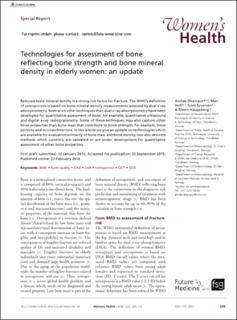Technologies for assessment of bone reflecting bone strength and bone mineral density in elderly women: An update
| dc.contributor.author | Dhainaut, Alvilde | |
| dc.contributor.author | Hoff, Mari | |
| dc.contributor.author | Syversen, Unni | |
| dc.contributor.author | Haugeberg, Glenn | |
| dc.date.accessioned | 2023-02-14T14:08:30Z | |
| dc.date.available | 2023-02-14T14:08:30Z | |
| dc.date.created | 2016-08-13T12:21:53Z | |
| dc.date.issued | 2016 | |
| dc.identifier.citation | Women's Health.. 2016, 12 (2), 209-216. | en_US |
| dc.identifier.issn | 1745-5057 | |
| dc.identifier.uri | https://hdl.handle.net/11250/3050788 | |
| dc.description.abstract | Reduced bone mineral density is a strong risk factor for fracture. The WHO’s definition of osteoporosis is based on bone mineral density measurements assessed by dual x-ray absorptiometry. Several on other techniques than dual x-ray absorptiometry have been developed for quantitative assessment of bone, for example, quantitative ultrasound and digital x-ray radiogrammetry. Some of these techniques may also capture other bone properties than bone mass that contribute to bone strength, for example, bone porosity and microarchitecture. In this article we give an update on technologies which are available for evaluation primarily of bone mass and bone density, but also describe methods which currently are validated or are under development for quantitative assessment of other bone properties. | en_US |
| dc.language.iso | eng | en_US |
| dc.title | Technologies for assessment of bone reflecting bone strength and bone mineral density in elderly women: An update | en_US |
| dc.type | Peer reviewed | en_US |
| dc.type | Journal article | en_US |
| dc.description.version | publishedVersion | en_US |
| dc.source.pagenumber | 209-216 | en_US |
| dc.source.volume | 12 | en_US |
| dc.source.journal | Women's Health. | en_US |
| dc.source.issue | 2 | en_US |
| dc.identifier.doi | 10.2217/whe.15.94 | |
| dc.identifier.cristin | 1372523 | |
| cristin.ispublished | true | |
| cristin.fulltext | original | |
| cristin.qualitycode | 1 |
